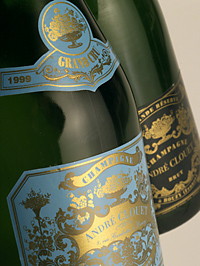 The wind kicks up eraser dust in Bouzy. In rare moments, standing alongside Grand Cru Pinot Noir vineyards and looking just a few dozen kilometers north toward the glitzy glam of Reims — the city that quite literally threw its trash here (used as fertilizer) into the late 1990s — it feels like class is in session.
The wind kicks up eraser dust in Bouzy. In rare moments, standing alongside Grand Cru Pinot Noir vineyards and looking just a few dozen kilometers north toward the glitzy glam of Reims — the city that quite literally threw its trash here (used as fertilizer) into the late 1990s — it feels like class is in session.
Writing over the garbage of its big city neighbors from Veuve Clicquot to Pommery to Mumm, the chalky soil that permeates Bouzy produces the most powerful sparkling wines in all of Champagne. Yet these wines — from humble houses like Andre Clouet — get very little attention, with none of the branding that the big houses have.
So to see Clouet’s Silver Brut, the winery’s dryest, most austere Champagne, making Wine Spectator columnist Matt Kramer’s shortlist for “Wine of the Year” is an absolute shock. In his quiet missive against the magazine’s own Top 100 wines, Kramer falls barely shy of calling the Bollinger-esque cuvee the best Champagne he’s ever had.
Bouzy is, itself, a shortlist. A region that anyone serious about enjoying wine would explore. The Pinot Noirs here contend with only Burgundy in intensity, and they arrive on the shelves for relative pennies to the dollar. Clouet’s Silver Brut (also known as the Brut Nature because no sugar is added to the bottle for dosage) retails for anywhere from $28-35 — a bargain by any standard for modern Champagne.
It’s the beauty of the small Grand Cru houses. With no money being pumped into marketing, we hardly pay any premium for the most premium of grapes. Differences in terroir shine through on the palate, but thankfully never find their way through the bar code.
Clouet’s line stretches out to the Grand Reserve Brut, ultimately the same wine as the Silver, but with a dosage that leaves it a bit less dry and steely; the 1911 Tete de Cuvee, a creamy blend of top vintages that would fetch three digits by any other name; and the glorious rosé, a wine that seems to get more intense, plush, and reminiscent of the drivingly vinous effort from Billecart-Salmon with each release.
These are not “cult” wines. They aren’t strange projects being put out by vagrant winemakers who want to challenge the status quo.
They are supremely and unequivocally the taste of Champagne, moreso than the swooshes of froth that line most retail shelves. And they will never be erased.